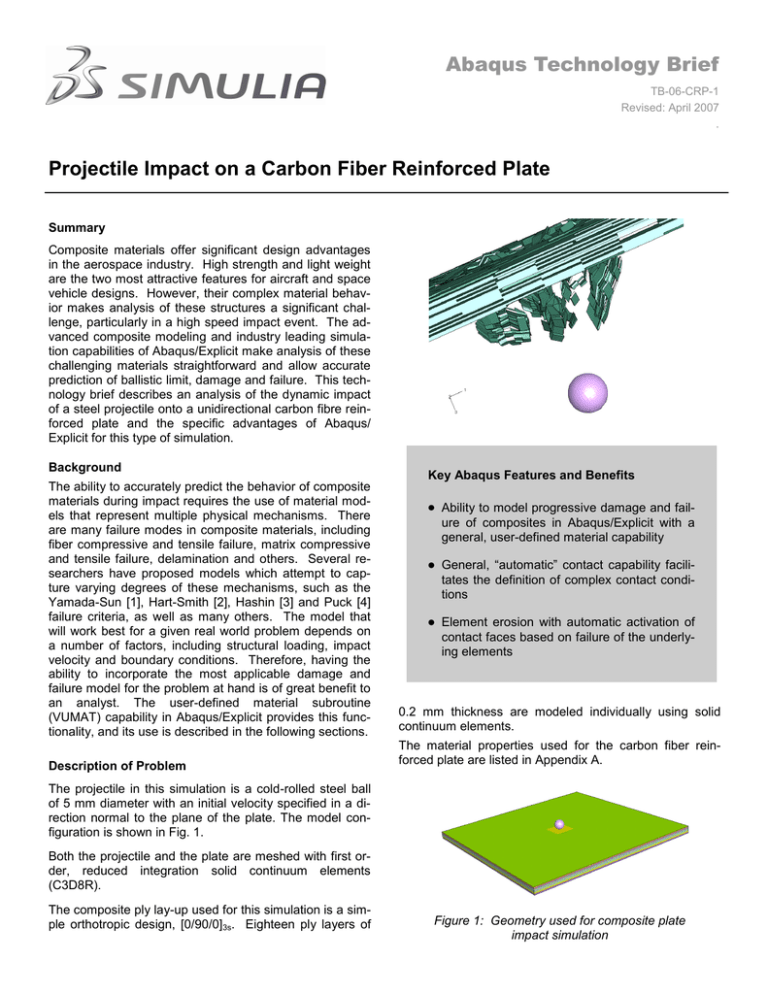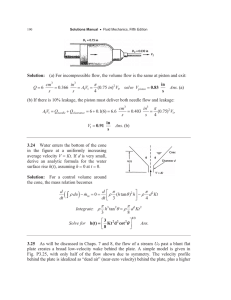Abaqus Technology Brief Projectile Impact on a Carbon Fiber Reinforced Plate
advertisement

Abaqus Technology Brief TB-06-CRP-1 Revised: April 2007 . Projectile Impact on a Carbon Fiber Reinforced Plate Summary Composite materials offer significant design advantages in the aerospace industry. High strength and light weight are the two most attractive features for aircraft and space vehicle designs. However, their complex material behavior makes analysis of these structures a significant challenge, particularly in a high speed impact event. The advanced composite modeling and industry leading simulation capabilities of Abaqus/Explicit make analysis of these challenging materials straightforward and allow accurate prediction of ballistic limit, damage and failure. This technology brief describes an analysis of the dynamic impact of a steel projectile onto a unidirectional carbon fibre reinforced plate and the specific advantages of Abaqus/ Explicit for this type of simulation. Background The ability to accurately predict the behavior of composite materials during impact requires the use of material models that represent multiple physical mechanisms. There are many failure modes in composite materials, including fiber compressive and tensile failure, matrix compressive and tensile failure, delamination and others. Several researchers have proposed models which attempt to capture varying degrees of these mechanisms, such as the Yamada-Sun [1], Hart-Smith [2], Hashin [3] and Puck [4] failure criteria, as well as many others. The model that will work best for a given real world problem depends on a number of factors, including structural loading, impact velocity and boundary conditions. Therefore, having the ability to incorporate the most applicable damage and failure model for the problem at hand is of great benefit to an analyst. The user-defined material subroutine (VUMAT) capability in Abaqus/Explicit provides this functionality, and its use is described in the following sections. Description of Problem Key Abaqus Features and Benefits Ability to model progressive damage and failure of composites in Abaqus/Explicit with a general, user-defined material capability General, “automatic” contact capability facilitates the definition of complex contact conditions Element erosion with automatic activation of contact faces based on failure of the underlying elements 0.2 mm thickness are modeled individually using solid continuum elements. The material properties used for the carbon fiber reinforced plate are listed in Appendix A. The projectile in this simulation is a cold-rolled steel ball of 5 mm diameter with an initial velocity specified in a direction normal to the plane of the plate. The model configuration is shown in Fig. 1. Both the projectile and the plate are meshed with first order, reduced integration solid continuum elements (C3D8R). The composite ply lay-up used for this simulation is a simple orthotropic design, [0/90/0]3s. Eighteen ply layers of Figure 1: Geometry used for composite plate impact simulation 2 Finite Element Analysis Approach The plate geometry was partitioned to include a central “target” location that allowed a finer mesh to be applied to the local impact zone. This finer mesh was transitioned to a coarse mesh at the outer edges of the plate using the swept meshing capability in Abaqus/CAE. Detail of the mesh used for the projectile and plate are shown in Figs. 2 and 3, respectively. The general contact algorithm greatly simplifies the definition of contact interactions, in that individual contact pairs are not required. It is only required to specify that any surface can potentially interact with any other surface in the model. To allow the projectile to interact with the internal plate material as elements erode, a surface was defined that included all interior faces of the plate mesh. This surface was then included in the general contact definition. The behavior of the unidirectional carbon fiber material was modeled with a user-defined material subroutine (VUMAT). The Hashin damage criterion was specified for the fiber failure modes, while the Puck criterion was used for the matrix failure modes. This approach was used since it has been shown that the Puck criterion provides a better prediction of matrix material damage for transverse compressive impact [4]. The flexibility of the VUMAT functionality makes it possible to utilize the most appropriate damage model for a particular application. The specific relationships used for fiber and matrix damage are as follows: Fiber tension: 2 d 2 2 11 12 13 X 1t S12 S13 Fiber compression: | d | 11 X 1c Matrix tension and compression: 2 d Figure 2: Detail of finite element mesh applied to steel ball projectile (a) Top view 2 22 11 2 X 1t X 2t X 2c 2 12 S12 22 1 X 2t 1 X 2c Results and Discussion The residual velocity of the projectile after exiting the back side of the plate is of primary interest in this type of analysis. Often a prediction of the ballistic limit velocity is the desired result in projectile impact simulation, and only by accurately simulating the residual velocity can this estimation be made. Three separate analyses were run for initial velocities of 150, 180 and 250 m/s and the results were compared to the published work of Kasano [5]. The comparison between the Abaqus analysis and the experimental data is shown in Appendix A. Very good agreement was found for all impact velocities. Figure 4 provides a graph with experimentally determined residual velocities as well as a fit of this data to a model equation developed by Kasano, VR (b) Through-thickness mesh detail Figure 3: (a, b) Detail of finite element mesh applied to composite plate Vi 2 Vb2 where Vi is the initial impact velocity, Vb is the ballistic limit velocity, and a is a mass coefficient representing the amount of material that separates from the plate. Also shown on the graph are the residual velocity results of the three Abaqus/Explicit analyses (detailed in Table A2). Note that no matching parameters or other constants required changing for any of the three analyses. The exact same model, including material parameters, was used for each simulation. 3 Figure 6 provides a view of the backside of the plate after the ball has penetrated fully through the structure. The liberated material is seen being ejected both from the back face as well as from the interior of the plate. Figure 4: Comparison of Abaqus simulation results to the experimental data of Kasano [5] A second area of interest in ballistic impact analysis is composite material damage and failure. Figure 5 shows a top view of the damage to the composite plate as the steel ball penetrates through the material. Significant damage occurs both locally as the ball penetrates, as well as globally due to propagation and reflection of stress waves through the material. The benefits of utilizing a ply-level model of the plate can be seen in Figure 7. In this figure, an individual ply from the interior of the plate is shown separately, and the locations of material failure can be clearly viewed (failed elements have been removed from the plot). Also evident is failure of the ply material at two edges of the plate. Due to the clamped boundary conditions applied to the structure, high stresses are experienced locally at these locations. Conclusions This Technology Brief has described the simulation of an orthotropic composite plate undergoing impact by a steel ball projectile. The modeling of the geometry, mesh and material properties was described, and the use of the VUMAT capability in Abaqus/Explicit was presented. By comparison with experimental data, it was shown that accurate results for residual velocity and material damage and failure can be achieved for this type of analysis. Figure 5: Top view sequence of steel ball impact on unidirectional fiber composite plate 4 Figure 6: Bottom view of composite plate damage after penetration by steel ball Figure 7: View of an individual ply from the interior of the plate showing significant damage Appendix A Table A1: Carbon fiber lamina material properties Young’s modulus, E11 235 GPa Young’s modulus, E22 Young’s modulus, E33 17 GPa 17 GPa Poisson’s ratio, n12 0.32 Poisson’s ratio,n13 0.32 Poisson’s ratio,n23 Young’s modulus,G12 0.45 4.5 GPa Young’s modulus,G13 4.5 GPa Young’s modulus,G23 2.5 GPa Tensile failure stress, X1t 3900 MPa Compressive failure stress, X1c 2400 MPa Tensile failure stress, X2t 111 MPa Compressive failure stress, X2c Tensile failure stress, X3t 290 MPa Compressive failure stress, X3c 50 MPa 290 MPa Failure shear stress, S12 120 MPa Failure shear stress, S13 137 MPa Failure shear stress, S23 90 MPa Table A2: Prediction of residual velocity after impact Impact velocity Residual velocity (predicted) Residual velocity (experiment) 150 m/s 52 m/s 45 m/s 180 m/s 107 m/s 102 m/s 250 m/s 174 m/s 184 m/s 5 References 1. Yamada, S. E.; and Sun, C. T.: “Analysis of Laminate Strength and Its Distribution”. J. Compos. Mater., Vol. 12, July 1978, pp. 275–284. 2. Hart-Smith, L. J.: “A New Approach to Fibrous Composite Laminate Strength Prediction”. Eighth DOD/NASA/ FAA Conference on Fibrous Composites in Structural Design, NASA CP-3087, Part 2, 1989, pp. 663–693. 3. Hashin, Z., “Failure Criteria for Unidirectional Fiber Composites”, Journal of Applied Mechanics, Vol. 47, 1980, pp. 329-334. 4. Paris, F. “A Study of Failure Criteria of Fibrous Composite Materials”, NASA/CR-2001-210661, March 2001 5. Kasano, H. “Impact perforation of orthotropic and quasi-isotropic CFRP laminates by a steel ball projectile”, Adv. Composite Mater., Vol. 10, No. 4, pp. 309-318, 2001 Abaqus References For additional information on the capabilities and techniques outlined above, see the following references to the Abaqus 6.11 documentation: Abaqus Analysis User’s Manual – “Damage and failure for fiber-reinforced composites,” Section 23.3 – “User subroutines: overview,” Section 17.1.1 About SIMULIA SIMULIA is the Dassault Systèmes brand that delivers a scalable portfolio of Realistic Simulation solutions including the Abaqus product suite for Unified Finite Element Analysis, multiphysics solutions for insight into challenging engineering problems, and lifecycle management solutions for managing simulation data, processes, and intellectual property. By building on established technology, respected quality, and superior customer service, SIMULIA makes realistic simulation an integral business practice that improves product performance, reduces physical prototypes, and drives innovation. Headquartered in Providence, RI, USA, with R&D centers in Providence and in Suresnes, France, SIMULIA provides sales, services, and support through a global network of over 30 regional offices and distributors. For more information, visit www.simulia.com The 3DS logo, SIMULIA, Abaqus, and the Abaqus logo are trademarks or registered trademarks of Dassault Systèmes or its subsidiaries, which include ABAQUS, Inc. Other company, product, and service names may be trademarks or service marks of others. Copyright © 2007 Dassault Systèmes



